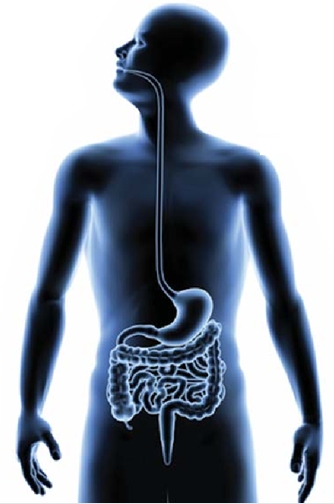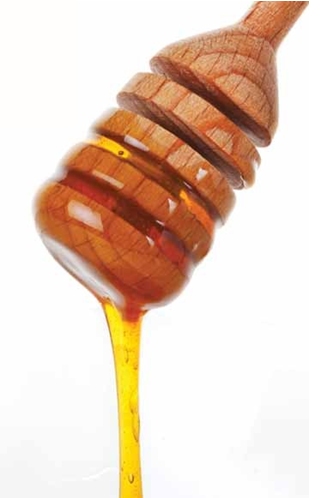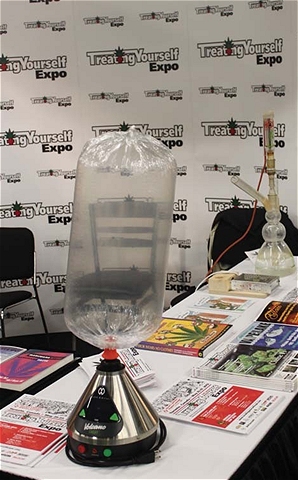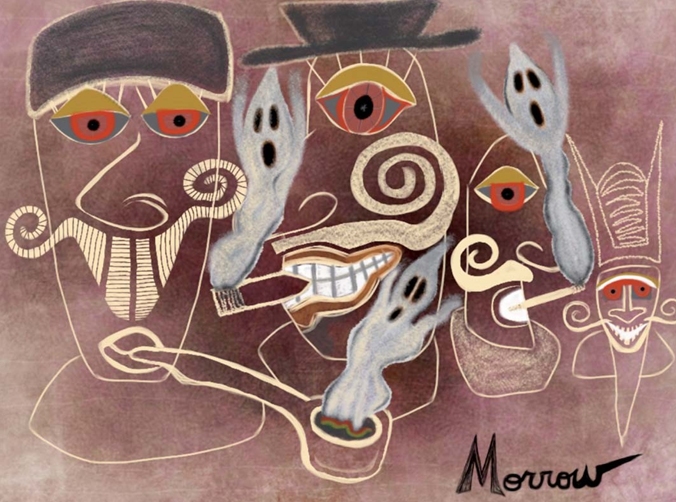
Inflammatory Comments
by Bill Drake
As a long-time TY reader I’ve noticed what seems to me to be a rather over- whelming number of stories of other TY readers who suffer from so-called gastro-intestinal ‘diseases’. I say so- called not because I am an expert, or
a doctor, or a scientist, but because the person I love most in the world has been on a very long and painful seven year journey during which she has been continually failed by every expert, scientist and doctor we have asked for help – although there have been a few who sincerely tried to be
helpful. During this journey we have had to basically help ourselves because as I’m sure you know if you have a med- ical problem that can’t be easily ‘cured’ most doctors quickly lose patience with you and can’t wait for you to disappear and stop ruining their self-image as infallible healers. So for years my wife and I have spent hundreds of hours researching the literatures of medicine, science, nutrition, folk-medicine, healing arts, and anywhere else we could think of looking, trying to discover what makes sense and what doesn’t. I would like to share some of what we believe are useful discoveries with you – in addi- tion of course to the one that all TY readers already understand, the almost magical properties of Cannabis and some of the other medicinal plants that we believe are gifts of the Great Spirit to the People of the world.
Your Tube
Your gut, as you know, is a long tube running from your
mouth to your anus. It’s
natural to think of your
gut as being inside your body,
but think about that for a
minute and you’ll realize that whatever
is inside your gut, that 36’ or so of tube, is actually outside your body. In a very real
sense, the walls of your
gut are the outside of your body
very much like your skin, and
whatever is inside your
gut
is not very different that whatever is on your skin – both are outside your body. The reason this is important to understand is that when your gut is compromised what is inside your gut, and therefore is naturally sup- posed to be kept outside your body, can
move into your body in ways that nature did not intend. Just like when your skin is broken and you get an infection because foreign materials (and bugs) have moved into your body and your body rallies its defenses, led by its #1 defense inflammation, when your gut is compromised materials (and bugs) that are supposed to be kept outside can move into your body where they trigger the
body’s defenses.
The skin is obviously somewhat permeable, but not in the same
way as the wall of the gut. In other words, you can absorb certain kinds of things through your skin, but your gut tis- sues are designed to be much more absorptive. One big difference between your skin and your gut is that the tis- sues of the gut are very specialized and are designed to allow nutrients from your food through so that you can be nourished. And that is where the beginnings of so many of our GI ‘diseases’ occur. When the gut tissues are compro- mised, and the barriers that have previously only allowed fully digested nutrients to move through the gut wall now allow other materials, like undigested proteins, to move through the wall, the body’s immune system is triggered and all kinds of hell break loose.
Good Bugs/Bad Bugs
One of the realities of our gut is that it is
absolutely chock full of bugs.
All kinds of bacteria thrive in
our gut, which as far as the
bugs are concerned is divided into
two sec- tions – the upper
gut and the lower gut.
To oversimplify a little –
not much – the good bugs live in your upper gut
and the bad bugs live in your lower gut.
The good bugs are all those species that are involved
in keeping you healthy,
helping you digest
your food, creating hormones that help regulate your body’s functions and,
importantly, keeping
HEALTH
of the gut wall wherever they establish their colonies, but in the upper gut there are no such defenses and before long these colonies of bad bugs begin creating weak spots in the wall of the upper gut. They do this in various ways – by secreting acids that eat through the tissues, by killing off the specialized cells that regulate nutrient transport, and by slipping through the gut wall themselves to make a new home somewhere comfy like your heart or brain. Medicine even has a name for this situation SIBO, or small intestine bacterial overgrowth. And the almost invariably prescribed ‘cure’ for SIBO? Well, you guessed it. More anti-biotics. If the phrase ‘vicious cycle’ is running through your mind at this point, you’re on target.
By the way, I’m sure you already know about the
impor- tance of taking wide-spectrum Pro-Biotics to help restore
the good bugs in your intestines
after taking any kind of anti-biotic. Most doctors will not tell you this – they just
prescribe or use these ‘medicines’ on you and then let you walk away to deal with the almost inevitable conse- quences. If I were a more cynical person I might suspect that they do
this because it is good for business – they ‘cure’ or ‘protect’ you with anti-biotics
and then because your
gut has been compromised you come back to them with all kinds of other
problems that they can also charge you
for ‘curing’. But that would
be really cynical of me, wouldn’t
it?
the bad bugs where they belong by colonizing the upper gut so completely that there is no place for the bad bugs to get a foothold even if they wanted to.
Now take some antibiotics. It doesn’t really matter what kind – any anti-biotic will do. What happens? Well of course the anti-biotic is designed to kill bacteria and while some antibiotics kill only bad bugs like those causing an infection somewhere in your body, many antibiotics kill bugs rather indiscriminately. So, one of the realities of life is that it is harder to kill bad bugs than it is to kill good bugs, so anytime that strong systemic antibiotics are used there is a big die-off of the good bugs in the upper gut, whereas the bad bugs in the lower gut hang in there. But the story doesn’t end there, unfortunately. After the battle there is lots of open territory in your upper gut where colonies of good bugs used to live, and the bad bugs some- how know that this is the case and they begin migrating upwards, staking out ground as they advance. And keep in mind that the bad bugs doing this are the ones who sur- vived the antibiotics – only now they are resistant and much harder to kill.
One of the reasons that
these are bad bugs, or pathogens, is that they don’t live in harmony
with their host. When they are
kept down in the lower gut,
there are strong nat- ural barriers
to keep them from breaking down
the tissues
Please realize if you don’t already that it isn’t enough to just eat yogurt containing acidophilus bacteria – in nature there are dozens of different kinds of bacteria and other micro-organisms that live in your gut, and just like in a forest or meadow diversity is the key to ecosystem health, so too in your gut. There are many different brands of wide-spectrum Pro-Biotics, and you don’t have to spend a fortune to get a good one. My advice – for what its worth
– is to look for a brand that has at least 3-4 billion bacte- ria per dose and has at least 6 different species of bacteria.
The Problem With ‘Medicines’
If you are one of millions of people who have been diag- nosed with gastrointestinal disease you already know that none of the expensive, often toxic ‘medicines’ and ‘treat- ments’ actually help much although, as my wife and I can testify, the ‘system’ is set up to keep draining you financial- ly until there is nothing left at which point you are cast aside, with your life ruined and your health unimproved. Readers of TY also know that not only medical marijua- na but many other inexpensive natural medicines can help tremendously, although there is still no cure for these dis- eases, merely better more natural ways of managing the symptoms than what conventional medicine has to offer.
Before I get into
some of the things that
my wife and have found actually can make a huge difference in your health if you
are living with a compromised
gut, let me first bring up what we have learned about an undiagnosed problem
directly related to a compromised gut that actually can be very effectively diagnosed and managed, and that affects at least 10-15 million people in North America alone without most of them knowing they are slowly being lit- erally eaten alive.
It all begins with your body’s immune system. I don’t pre- tend to understand this complex system of defenses, but I do know one important thing, and that is that the immune system can sometimes go a little crazy and start doing things it was never supposed to do – like attacking the body itself rather than attacking outside threats to the body that have somehow entered or invaded the body. This is called an auto-immune response, headed by inflammation, and is I believe at the root of a huge undi- agnosed problem that I hope readers of TY will think about carefully.
Many if not most people who suffer from intestinal dis- eases also have been diagnosed, or just simply know from their own experience, that they are either sensitive to or intolerant of gluten. Briefly gluten is a naturally occurring protein found concentrated in wheat and related grass seeds – what we call grains in our diet. Without going into detail, which is readily available elsewhere, modern wheat bears little if any resemblance to its natural ancestors. The two biggest ways that modern wheat varies is that it is extremely high on the glycemic index, and it is extremely high in gluten.
But this article isn’t about gluten, so let me move to the key point I want you to know. When the body is gluten-sensi- tive or intolerant this can only occur because the gluten is moving from inside your gut through the wall of the gut as an undigested protein, and the immune system which is always on high alert for foreign proteins (like bacteria or viruses) sees it and attacks. The results are so unpleasant that many people try, and some succeed, in switching to a gluten-free diet. But here is the important point. What these folks, and those who don’t stop eating gluten, don’t realize is that the gluten protein molecule is a precise dou- ble for a protein found in the human thyroid, and once the immune system has been triggered to attack a gluten mol- ecule that has migrated through the intestinal wall it is for- ever on the outlook for precisely that protein. Whenever it detects that protein it will attack and destroy it.
Which means (I know you’re ahead of me here) that once your
immune system is trained to attack gluten it will start attacking your thyroid too and will not stop until your thyroid is destroyed. There is a name for this process and it is Hashimoto’s
Thyroiditis, and it is estimated that 10- 15 million
people in North America have it and
don’t know
it and so, of course, are
not treating it. The really
strange part of this is that
while your immune system is
attacking and destroying your thyroid, the most common
tests for thyroid function that doctors order – the T3
and
T4 tests – will almost always show that your thyroid is normal. Unless your doctor orders two tests for thyroid antibodies (names of tests) there is no way to know whether or not your thyroid is being destroyed by your body’s immune system. But once you have these simple, inexpensive tests, if they reveal that you do have Hashimoto’s, a small miracle will come your way. Once you begin hormone replacement therapy, which is as sim- ple as a very small dose of thyroid hormone every day, you will be amazed at how much better you begin to feel almost immediately. Many of your gastrointestinal symp- toms will in fact begin to diminish and disappear. If you have been going through these painful, unpleasant, debil- itating symptoms for many years, and many people have, it will seem almost too good to be true. And while it is not too god to be true, it is still not enough – there is more that you must do. But at least you will now be getting signifi- cant relief.
The Role of Diet
I’ve already promised that I won’t try to propose
some universal cure for GI “diseases“ like IBS, colitis and Crohns. For many TY readers it
is enough that medicinal marijuana
provides daily relief, and some may
not want to go to the trouble
of going further in self-treatment, espe- cially through making
dietary changes that can be diffi- cult. But for those who are motivated
I would like to make a few
recommendations for things
you
might try.
No promises, but these
methods have worked for
my wife and for
others.
We’ve already discussed the role of gluten in triggering your body’s immune sys- tem, but for people with a compromised gut, whether from bacterial overgrowth due to misuse of antibiotics or for whatev- er reason, it is very important to ensure that
no proteins can make it through your gut walls into your
bloodstream because while the immune system is on guard for many different kinds of things, foreign life forms are always protein-based, and so any proteins – not just gluten – that get through the gut wall barrier trigger a mas- sive immune response led by whole-body inflammation. This inflammation isn’t easy to understand or diagnose – it can mask itself as weight gain or as a wide range of other symptoms which appear to have no specific origin. Also whole-body inflammation isn’t like an infected finger or toe – it isn’t localized and therefore doesn’t stand out from the surrounding tissue. It is everywhere, and it is so subtle that most of us never spot it the way we would a more localized infection with inflammation.
Fortunately there is a relatively simple change that you can make that will reduce the migration of proteins through the gut wall and therefore greatly reduce the inflammation that always accompanies immune system‘s inflammatory auto-immune response and that, in turn, lies at the heart of so much of what we call disease – espe- cially disease that appears to Western medicine to have no specific cause. If it isn’t a bug or virus causing the disease, or an injury, or a cancer, or degeneration of an organ – then Western medicine is pretty much stumped. While many doctors are beginning to appreciate the role of inflammation in these diseases without an obvious origin, allopathic (Western) medicine still has very few effective tools for dealing with inflammation, which means that you are pretty much on your own.
But, here’s what you can do. It is called
partitioning your diet, and the principles are simple. You divide
your meals into two parts. Part
one is the protein, and
Part two is everything else. Since
undigested proteins are one of
the major triggers of immune system’s
auto-immune response leading to
inflammation, divide your meals
into a protein part
which you eat first, and then wait 30 minutes for your stomach acid to break it all down into the smallest
possible components that can then be processed by the enzymes in your upper gut so that no undigested protein remains to penetrate the compromised wall of your gut. It takes about 30 minutes for the protein component of your meal to be broken down. Since so many ‘treatments’ of GI problems involve taking ‘medicines’ like Omeprazole that act to reduce stomach acid, if you are taking any of these drugs you may need to look into natural digestive aids like enzymes to help you break this protein down once it makes it into your upper gut. It is important not to drink liquids during the time your protein meal is in your stom- ach – this dilutes the stomach acid and defeats the goal of complete breakdown of the proteins.
Once you’re confident that your stomach has emptied go ahead and enjoy the your veggies and, if you can tolerate them, maybe non-gluten grains like rice and quinoa – although some people simply have to get all grains out of their diet. If you have had a compromised gut for a while you may also have developed multiple food allergies. Some of these can seem very strange. My wife, for exam- ple, reacts very strongly to all citrus, to pineapple, dairy and simple carbs like potatoes. She has decided that she just has to adjust to life without these things in her diet and is strong-willed enough to stick to her decision. I know that there are times she would kill for a bag of potato chips or a pizza with triple cheese, but she has made the decision that she would rather not be sick and so these things are gone forever. I hope that you, reading this, are not forced to such extremes but if you are I hope and pray that you will find the strength to treat yourself right and do whatever is necessary.
In honor of the central theme of Treating Yourself, the role of marijuana in self-treatment of a wide range of dis- ease, let me offer three research citations that show that Marijuana plays its therapeutic role by reducing inflam- matory responses – in other words, by regulating the immune system to reduce its auto-immune activities. These studies point to why so many TY readers who are using Marijuana to treat their inflammatory diseases, whether of the bowel or elsewhere in the body, are hav- ing so much relief.
I’m writing this article to urge
you not to stop there, but if you are not already taking some of the other
steps cov- ered here to treat the
underlying cause of the inflamma- tory response rather than simply
treating it with Marijuana, you might benefit greatly from doing so. The changes that you have to make
to get further relief may or may not be drastic – everyone is
different. But since you already know that there is at least
one natural way to treat a medical problem that has the best
minds in Allopathic medicine pretty much stumped, why not con- sider going even further and acting to remove some, if not all, of
the major underlying causes of the problem that arise from what you eat and
how you eat.
liquid chromatography-mass spectrometry. Human
colon adenocarci- noma (Caco-2) cells were used to evaluate the effect of cannabidiol on oxidative stress.
Cannabidiol reduced
colon injury, inducible iNOS (but not cyclooxygenase-2) expression, and interleukin-1beta, inter-
leukin-10, and endocannabinoid
changes associated with 2,4,6-dini- trobenzene sulfonic acid administration. In Caco-2 cells,
cannabidiol reduced reactive oxygen
species production and lipid peroxidation. In conclusion, cannabidiol, a likely safe compound, prevents experimen- tal
colitis in mice
Israel Med Assoc J. 2011 Aug;13(8):455-8.
Treatment of Crohn’s disease with cannabis: an observational study.
Naftali T, Lev LB, Yablecovitch D, Half E, Konikoff FM.
Source
Institute of Gastroenterology and Hepatology, Meir Medical Center, Kfar Saba affiliated with Sackler Faculty of Medicine, Tel Aviv University, Ramat Aviv, Israel. naftali@post.tau.ac.il
BACKGROUND:
The marijuana plant cannabis is known to have therapeutic effects, including improvement of inflammatory processes. However, no report of patients using cannabis for Crohn’s disease (CD) was ever published.
OBJECTIVES:
To describe the effects of cannabis use in patients suffering from CD.
METHODS:
In this retrospective observational study we examined disease activity, use of medication, need for surgery, and hospitalization before and after cannabis use in 30 patients (26 males) with CD. Disease activity was assessed by the Harvey Bradshaw index for Crohn’s disease.
RESULTS:
Of the 30 patients 21 improved significantly after treatment with cannabis. The average Harvey Bradshaw index improved from 14 +/-
6.7 to 7 +/- 4.7 (P < 0.001). The need for other medication was sig- nificantly reduced. Fifteen of the patients had 19 surgeries during an average period of 9 years before cannabis use, but only 2 required surgery during an average period of 3 years of cannabis use.
Journal of Molecular Medicine (Berlin). 2009 Nov; 87(11):1111-21. Epub 2009 Aug 20.
Cannabidiol, a safe and non-psychotropic ingredient of the marijua- na plant Cannabis sativa, is protective in a murine model of colitis. Borrelli F, Aviello G, Romano B, Orlando P, Capasso R, Maiello F, Guadagno F, Petrosino S, Capasso F, Di Marzo V, Izzo AA.
Source
Department of Experimental Pharmacology, University of Naples Federico II, via D Montesano 49, 80131 Naples, Italy.
Abstract
Inflammatory bowel disease affects millions of individuals; neverthe- less, pharmacological treatment
is disappointingly unsatisfactory. Cannabidiol,
a safe and non-psychotropic ingredient of
marijuana, exerts pharmacological effects (e.g.,
antioxidant) and mechanisms (e.g., inhibition of endocannabinoids enzymatic degradation)
poten- tially beneficial for the inflamed gut. Thus, we investigated the effect of cannabidiol in a murine
model of colitis. Colitis was induced
in mice
by intracolonic administration of dinitrobenzene sulfonic acid. Inflammation was assessed both macroscopically and histologically.
In the
inflamed colon, cyclooxygenase-2 and inducible nitric
oxide syn- thase (iNOS) were evaluated by Western blot, interleukin-1beta and interleukin-10 by ELISA, and endocannabinoids by isotope dilution
Arthritis Res Ther. 2008;10(2):R43. Epub 2008 Apr 16. Characterisation of the cannabinoid receptor system in synovial tissue and fluid in patients with osteoarthritis and rheumatoid arthritis.
Richardson D, Pearson RG, Kurian N, Latif ML, Garle MJ, Barrett DA, Kendall DA, Scammell BE, Reeve AJ, Chapman V.
Source
Centre for Analytical Bioscience, School of Pharmacy, University of Nottingham, Nottingham, NG7 2RD, UK. denise.richardson@pfizer.com
Abstract INTRODUCTION:
Cannabis-based medicines have a number of therapeutic indications, including anti-inflammatory and analgesic effects. The endocannabi- noid receptor system, including the cannabinoid receptor 1 (CB1) and receptor 2 (CB2) and the endocannabinoids, are implicated in a wide range of physiological and pathophysiological processes. Pre-clinical and clinical studies have demonstrated that cannabis-based drugs have therapeutic potential in inflammatory diseases, including rheumatoid arthritis (RA) and multiple sclerosis. The aim of this study was to determine whether the key elements of the endocannabinoid signalling system, which produces immunosuppression and analge- sia, are expressed in the synovia of patients with osteoarthritis (OA) or RA.
METHODS:
Thirty-two OA and 13 RA patients undergoing total knee arthroplas- ty were included in this study. Clinical staging was conducted from x- rays scored according to Kellgren-Lawrence and Larsen scales, and synovitis of synovial biopsies was graded. Endocannabinoid levels were quantified in synovial fluid by liquid chromatography-mass spectrometry. The expression of CB1 and CB2 protein and RNA in synovial biopsies was investigated. Functional activity of these recep- tors was determined with mitogen-activated protein kinase assays. To assess the impact of OA and RA on this receptor system, levels of endocannabinoids in the synovial fluid of patients and non-inflamed healthy volunteers were compared. The activity of fatty acid amide hydrolase (FAAH), the predominant catabolic endocannabinoid enzyme, was measured in synovium.
RESULTS:
CB1 and CB2 protein and RNA were present in the synovia of OA and RA patients. Cannabinoid receptor stimulation of fibroblast-like cells from OA and RA patients produced a time-dependent phosphoryla- tion of extracellular signal-regulated kinase (ERK)-1 and ERK-2 which was significantly blocked by the CB1 antagonist SR141716A. The endocannabinoids anandamide (AEA) and 2-arachidonyl glycerol (2- AG) were identified in the synovial fluid of OA and RA patients. However, neither AEA nor 2-AG was detected in synovial fluid from normal volunteers. FAAH was active in the synovia of OA and RA patients and was sensitive to inhibition by URB597 (3′-(aminocar- bonyl) [1,1′-biphenyl]-3-yl)-cyclohexylcarbamate).
CONCLUSION: Our data predict that the cannabinoid receptor system present in the synovium may be an important therapeutic target for the treatment of pain and inflammation associated with OA and RA.








